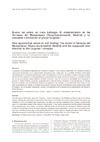Please use this identifier to cite or link to this item:
https://accedacris.ulpgc.es/jspui/handle/10553/75624
| Title: | Nueva luz sobre un viejo hallazgo: El enterramiento de las Terrazas del Manzanares (Rivas-Vaciamadrid, Madrid) y su supuesta vinculación al grupo Cogotas I | Other Titles: | New approaches about an old finding: The burial of terrazas del Manzanares (Rivas-Vaciamadrid, Madrid) and the supposed relationship to the Cogotas I complex | Authors: | Esparza Arroyo, Ángel Velasco Vázquez, Francisco Javier Delibes de Castro, Germán |
UNESCO Clasification: | 550405 Prehistoria 550501 Arqueología |
Keywords: | Peninsula Pit Burial. Bronze Age Cogotas I Chalcolithic Bell Beaker, et al |
Issue Date: | 2015 | Journal: | Cuadernos De Prehistoria Y Arqueologia-Universidad Autonoma De Madrid | Abstract: | The shortage of information about the "Cogotas I Culture" belonging to the Middle/Late Bronze Age in the Iberian Plateau, explains the expectation created by the discovery of a new burial site in Rivas-Vaciamadrid, half century ago. Published in 1974, not without some controversy, the burial was promptly attributed to the Cogotas I culture on the basis of a radiocarbon dating of the skeleton, the presence of two bronze spearheads and its possible relationship with a representative set of pottery of that time. With the death of it discoverer, the geologist C. Gaibar Puertas, the location of archaeological items remained forgotten, making its revision impossible. However, its recent finding, along with some of Gaibar's manuscripts, in the National Museum of Natural Sciences (Madrid) has allowed their study, providing the unexpected result of that most likely the place was a burial of the end of the Copper Age. La escasez de documentos funerarios del “horizonte Cogotas I”, en el Bronce Medio/Final de la Meseta, explica la expectación despertada por un enterramiento descubierto hace medio siglo en la localidad de Rivas-Vaciamadrid. Una inhumación no exenta de polémica que, nada más publicarse en 1974, se adscribió a Cogotas I gracias una datación de 14C del esqueleto, al acompañamiento excepcional de dos puntas de lanza de bronce y a su posible relación con un lote de cerámicas representativas de dicho momento. A raíz de la muerte del descubridor de la sepultura, el geólogo C. Gaibar Puertas, se perdió completamente la pista de dichos materiales, lo que impidió que el hallazgo fuese reexaminado como reivindicaban distintos investigadores. Sin embargo, su reciente localización, junto con una serie de borradores de Gaibar, en el Museo Nacional de Ciencias Naturales de Madrid ha hecho posible una revisión de conjunto con el resultado, inesperado, de que muy probablemente se trataba de un enterramiento del final de la Edad del Cobre |
URI: | https://accedacris.ulpgc.es/handle/10553/75624 | ISSN: | 0211-1608 | DOI: | 10.15366/cupauam2015.41.003 | Source: | Cuadernos De Prehistoria Y Arqueologia-Universidad Autonoma De Madrid [ISSN 0211-1608], v. 41, p. 39-54, (2015) |
| Appears in Collections: | Artículos |
WEB OF SCIENCETM
Citations
1
checked on Jul 10, 2022
Page view(s)
99
checked on May 12, 2024
Download(s)
72
checked on May 12, 2024
Google ScholarTM
Check
Altmetric
Share
Export metadata
Items in accedaCRIS are protected by copyright, with all rights reserved, unless otherwise indicated.
